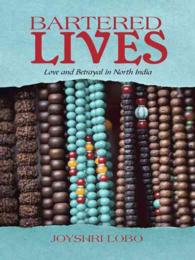- ホーム
- > 洋書
- > 英文書
- > Literary Criticism
Full Description
Highlights connections between authors rarely studied together by exposing their shared counternarratives to germ theory's implicit suggestion of protection in isolation.
Kept from All Contagion explores the surprising social effects of germ theory in the late nineteenth century. Connecting groups of authors rarely studied in tandem by highlighting their shared interest in changing interpersonal relationships in the wake of germ theory, this book takes a surprising and refreshing stance on studies in medicine and literature.
Each chapter focuses on a different disease, discussing the different social policies or dilemmas that arose from new understandings in the 1860s-1890s that these diseases were contagious. The chapters pair these sociohistorical considerations with robust literary analyses that assess the ways authors as diverse as Thomas Hardy, Henrik Ibsen, and Mary Elizabeth Braddon, among others, grappled with these ideas and their various impacts upon different human relationships-marital, filial, and social.
Through the trifocal structure of each chapter (microbial, relational, and sociopolitical), the book excavates previously overlooked connections between literary texts that insist upon the life-giving importance of community engagement-the very thing that seemed threatening in the wake of germ theory's revelations. Germ theory seemed to promote self-protection via isolation; the authors covered in Kept from All Contagion resist such tacit biopolitical implications. Instead, as Kari Nixon shows, they repeatedly demonstrate vitalizing interpersonal interactions in spite of-and often because of-their contamination with disease, thus completely upending both the ways Victorians and present-day literary scholars have tended to portray and interpret purity.
Contents
List of Illustrations
Acknowledgments
Introduction: "The Germ Theory Again": Disease, Ideology, and the Possibilities of Biotic Life in the World of Antibiotic Purity
1. Keep Bleeding: Plague, Vaccination Debates, and the Necessity of Leaky Boundaries in Defoe's Journal of the Plague Year and Shelley's The Last Man
2. "A Speculative Idea": Childbed Fever, Early Germ Theory Debates, and (En)gendered Speculation in Henry James's Washington Square
3. Separation and Suffocation: Tuberculosis, Etiological Uncertainty, and Female Friendship in Women's Fiction
4. Tainted Love: Venereal Disease, Morality, and the Contagious Disease Acts in Ibsen's Ghosts and Hardy's The Woodlanders and Jude the Obscure
5. Humanity's Waste: Typhoid Fever, the Failure of Isolation, and the Development of Probiotics in Three Late-Century Works
Conclusion: Shuffling Within Our Mortal Coil
Notes
Works Cited
Index






